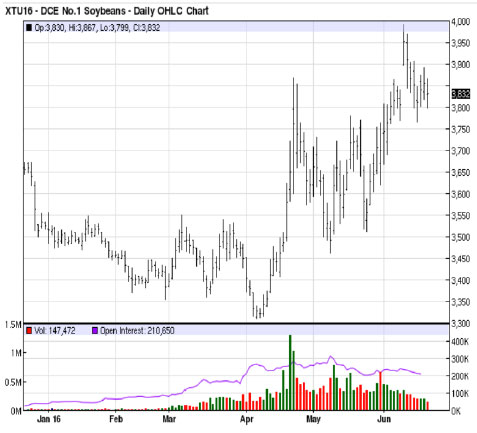- Dalian soybean meal prices have soared since the closing days of March on surging hog profitability and short bought end users expecting cheap S American soybean offers. The initial rally sparked record large volume has recently been in decline. The market is technically starting to look rather toppy with a push to new highs needed next week to maintain the upside momentum. Curtailed 2016 S American soybean production is behind the Chinese soymeal rally. China’s hog herd is only slowly expanding, due to environmental issues, even amid record feeding margins. It’s not a surge in snouts that’s rallying Chinese meal demand, but rather an expansion in the supply pipeline that had become depleted via a pervasive bearish meantaility. A top is likely forming unless Chinese or Central US weather worsens.
- Soybeans bounced on technical buying and rumors of both old and new crop exports to China. November caught support just above $11, where at the low of the day was nearly $.83 under last week’s high. The product markets were mixed, with old crop. Brazilian soybean basis has been over the US since March, while Argentina has been at or above (last week) the US. Any additional world demand will likely be directed towards the US from here forward. The USDA Quarterly Stocks and Acreage reports are a week away, with just one trading day between the report and the long holiday weekend. Independence Day has proven to be a critical pivot point in weather markets, but ahead of the USDA reports, November soybeans are likely trapped in a broad range of $10.75-11.50. The June soybean seeding data has often confounded and caught out even the most astute trader.
- Corn continues to struggle as rain moves across the E Midwest and S American basis levels are in fast retreat. Lower Argentine fob basis and reducing Brazilian domestic prices as harvest advances should see overall S American prices fall further in the next 3-6 weeks. Export competition is now well and truly back for the US into early 2017. Note also that China has so far sold 8.8 million mt of its corn reserve stocks into the domestic market with auction prices in decline. Heavy rains will linger across the E Midwest through Thursday and a series of weak systems are forecast to follow next week. Uncertainty over totals and coverage persists, but a broad Ridge/Trough pattern through the next 10 – 12 days will boost rain chances and maintain seasonal temperatures. Pollination begins across the S Midwest next week and yield potential remains high. As we have said previously, June weather does not correlate with yield. Tuesday was important for corn’s chart pattern, and substantial damage has been done. Additional long liquidation is expected without adverse weather in early July.
- In wheat short covering was noted early, but US futures and global cash prices ended little changed following Tuesday’s decline. US weekly export sales on Thursday are expected in a range of 400-600,000 MTs, but otherwise fresh news is lacking. The USDA did update its vegetation health maps for all major producing countries this morning. Of note, ratings deteriorated further across Central Europe, and the USDA’s yield forecast may be overstated, but elsewhere conditions remain well above normal and last year. The N American weather pattern maintains above normal precipitation and near/above normal temps across the Canadian Prairies, ND and MN through early July. There’s still no sign of an Egypt’s first new crop tender, and now fraud has been attached to its domestic purchases this spring. Political/economic turmoil has weighed on N Africa/mid-East wheat import demand. A period of consolidation may lie ahead until EU quality can be assessed, but we maintain a bearish outlook on rallies. It remains that the US only competes for world trade below $4.50, basis Sep Chicago futures.
- Our latest thoughts on the wheat situaion in Russia can be downloaded by clicking on the link below:

